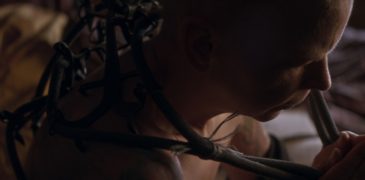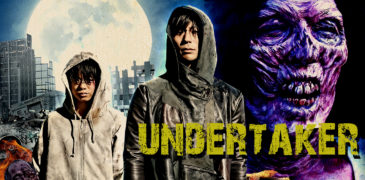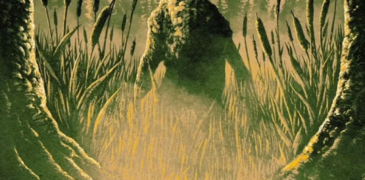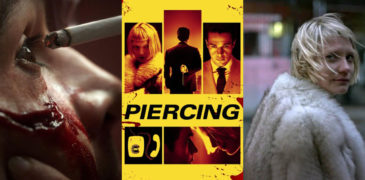
A film that begins by claiming everything we are about to see is based on true events, and ends with an imminent Apocalypse, puts the viewer in a strange place indeed. Are we watching from the other side of a Doomsday we can’t even remember happening? Are we already on Team Zombie and we don’t even know it? Is this why the popcorn is so unsatisfying? Or has this movie been lying to us, just like that other movie lied to us so many years ago? The old black and white one that told us there were ways to manage such an infestation of the undead if (when) it ever happened. Just a shot to the brain, it said. Easy enough. Something to make us believe we actually stood some kind of a chance.
Of course, we don’t really believe Return of the Living Dead is reporting back to us from the real-world streets we live on. Its campy, punk performances and cartoonishly garish violence are clearly played as pure cinema, something that can safely be contained up on the screen. But the movie definitely wants us to feel uneasy about the truth. To blur the line that has been drawn between us and it. When it acknowledges how it has seen the same movies we’ve seen too—one character even looking into the camera to ask if we remember Night of the Living Dead—the question is offered to us like a secret handshake. Something that makes us believe that those we are watching in the film were once where we are. Sitting in a theatre, in the dark, assuming it is all just a movie. When it claims to have proof that zombies really exist, we find ourselves more than eager to follow it down into the basement so it can show us.
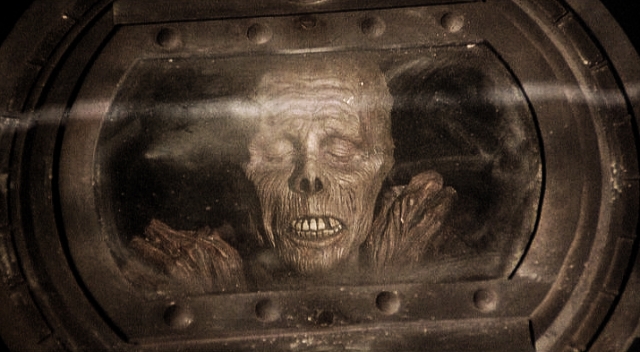
What we will end up finding down here will be the canisters of gas responsible for the zombie outbreak in George Romero’s original film. And when the inevitable happens—mysterious toxins expelled, corpses shaking back to life, the living getting themselves eaten by the curiously perfect teeth of the dead—there is a grimly celebratory element to the event. At least in the beginning. As we start to discover evidence of reanimation amongst the specimens of a medical supply warehouse, we might find ourselves even laughing. It’s almost cute when we come across a bisected dog yelping on the floor. Or when we catch sight of butterflies pinned to a board beginning to flutter their wings free from their paper-thin rigor-mortis. And when a thumping comes from inside of the walk-in freezer where they keep the corpses, we almost want them to open the door. We are horror fans. This is what we came for.
Maybe this initial brave attitude has something to do with the fact that we feel we have the upper hand, having seen this kind of movie before. Maybe we trust the characters to handle this properly since they’ve seen them to. But whatever it is, the threat seems muted. It feels like these zombies have only risen from the dead to give us a cheap thrill. Then, once they’ve been thoroughly dispatched with a number of quality headshots, we can safely go back to our regularly scheduled life.
But then something unexpected happens that disrupts this illusion of safety. Something that will turn this from being a spectacle we are simply watching unfold, to an event we suddenly feel unprepared for if it were to really happen to us. It turns out the one defence we’ve learned from the movies does not, in fact, work. This becomes clear as we witness the business-end of a pick-axe get itself buried deep into the brain of the first reanimated zombie with almost no effect. And while at first, we might still laugh as this resurrected corpse continues to kick and scream on the floor like some underfed baby, the aftershock of this failure is what the rest of the film seems to reel from. These characters we have aligned with, who have confided in us, have been betrayed by the zombie lore we have both been using as scripture. They, like us, are now forced to figure things out for themselves. And before we can find the words of just how deceived we are now feeling, they will be said best up on screen by poor Freddy, who so far has been suffering the worst first day of work in the history of cinema.
“You mean the movie lied?”
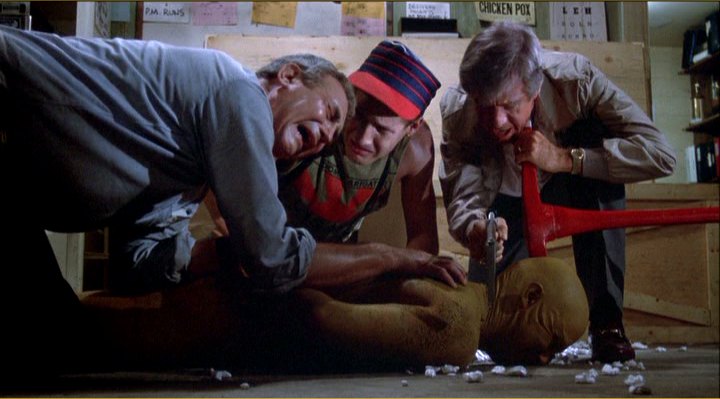
Such a question calls into focus the notion of dealing with a zombie infestation as a problem not of the cinematic world but of the world we live in. Abandoned by films and everything they have taught us, we now witness these characters stand around at a loss over what they should do next. And as we watch them scramble to uncover some new way of disposing of the undead, it is important to take note of how it will take close to half of the films running time to deal with just one of these infernal creatures. An arduous process of cutting them into pieces. Burning them down to ash in a crematorium. Even the bones. Even the heart. The movie makes sure not to condense these steps through editing. We witness the whole procedure. The sweat. The heavy lifting. All the unseemly details. It is an exhausting prospect, especially as we begin to witness more and more of the undead crawling up from their graves. Not only is the threat mounting, but it also looks like it is going to be way too much work to even bother trying to survive if this is the solution.
It is this sense of hopelessness that makes the rest of Return of the Living Dead such compellingly anxious viewing. Even when filled with a cast of colourful characters, in a situation where even the zombies sometimes crack wise about needing more paramedics, the movies underlying tone is pure nihilism. No matter how much our protagonists swing baseball bats, fling acid, cut off limbs or shoot endless bullets, there are no victories to celebrate. Not a single zombie will drop to the ground and stay there. Over the final 45 minutes of the film, only the living will die, as the dead just keep coming.
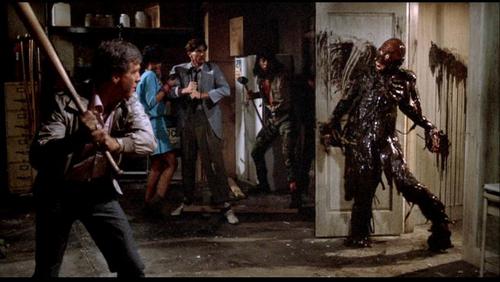
It’s a spectacular climax. Not only a blast of viscerally terrifying fun, but also an existential nightmare that ends up almost completely draining us. And while some might view the nuclear apocalypse that ends the film as an empty victory, there is almost a sense of relief when we finally get to see the undead temporarily stopped. Caught in a freeze frame as they breach the final hiding spot of the living. And even if it is only for a moment, at least it allows us to catch our breath so we can get back to laughing at this predicament again. Because what else can we do as we listen to a military voice over claim complete victory, when we know it is anything but. Clearly, the generals haven’t been watching the movie we have just watched. Are hardly equipped for the threat of a real zombie apocalypse.
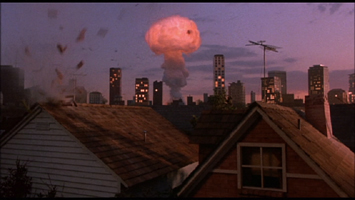
And so in these final minutes of the movie we can only sit there, watching as toxic storm clouds begin to brew with a weird bemusement. Knowing what is about to happen after the film is over. Imagining the horror of it happening all over again, only now, somewhere else. Maybe even here. Maybe just outside our door. Then, as we step out into the night, we might find ourselves beginning to laugh even harder when we discover it is raining on our lonesome walk home from the theatre, and that there really is no hope. No hope at all.
More Film Reviews
Musicals are my thing, they have been for as long as I can recall enjoying cinema, there is something so inherently magical about the world breaking out in song. For… “Every day we stray further from God’s light” may be a ‘meme-able’ saying, but it is one that is none-the-less true when we look at a mix of contempt and… While zombie flicks are a dime a dozen here in the West, the walking dead don’t really occupy the same space in Japanese horror. Not to say that there have… Johanna is just twenty years old but struggling with her boring and aimless existence. Disturbing visions start the day she gets fired from her job. Soon Johanna is carried off… There is something undeniably eerie about found footage films that delve into the mythologies we once loved and believed in. They offer a glimpse into a parallel universe of “what… Book-to-film adaptations often get a bad rap. It’s rare for them to truly satisfy the audience, and they hardly ever live up to the expectations of the fans of the…Powertool Cheerleaders vs the Boyband of the Screeching Dead (2022) Review – Sing Into The Chainsaw!
Luzifer (2021) Film Review – Religious Fervor and Unforgiving Isolation
Undertaker (2012) Film Review – Digging the Undead
Dark Circus (2016) Film Review – The Goths Are Alright
Frogman (2024) Film Review- Frog Around and Find Out!
Piercing (2018) film review- A gory adaptation done right

